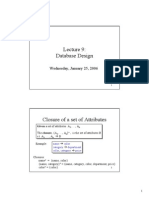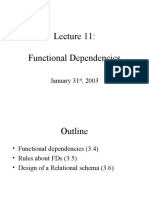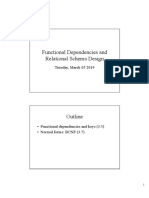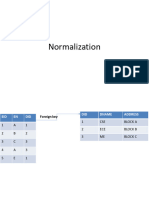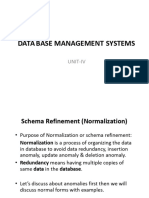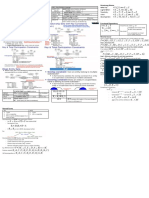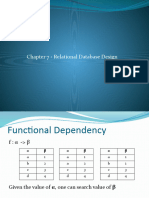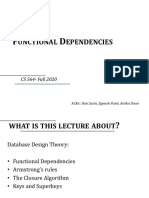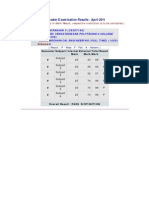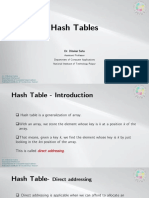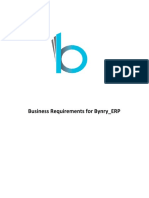Lecture 9: Database Design
Wednesday, January 25, 2006
Closure of a set of Attributes
Given ,,, Givenaaset setof ofattributes attributes A A 11 ,A A nn
+ The ,,{A ,,, } Theclosure closure {A 11 ,A A nn }+,, is isthe theset setof ofattributes attributesB B s.t. A , , A B 11, , A nn B s.t. A
Example:
name name color color category category department department color, color,category category price price
Closures: name+ = {name, color} {name, category}+ = {name, category, color, department, price} color+ = {color} 2
�Closure Algorithm
Start Startwith withX={A1, X={A1,, ,An}. An}. Repeat :: Repeatuntil untilX Xdoesnt doesntchange change do do if if B ,,, B 11 ,B B nn C C is isaaFD FDand and B ,,, B 11 ,B B nn are areall allin inX X then then add addC Cto toX. X. Example: name name color color category category department department color, category color, category price price
{name, category}+ = { name, category, color, department, price } Hence: name, name,category category color, color,department, department,price price
3
Example
In class: R(A,B,C,D,E,F) A, A,B B C C A, D E A, D E B B D D A, F A, F B B
Compute {A,B}+
X = {A, B,
} }
4
Compute {A, F}+ X = {A, F,
�Why Do We Need Closure
With closure we can find all FDs easily To check if X A
Compute X+ Check if A X+
Using Closure to Infer ALL FDs
Example: A, A,B B C C A, A,D D B B B D B D
Step 1: Compute X+, for every X: A+ A+= =A, A, B+ B+= =BD, BD, C+ C+= =C, C, D+ D+= =D D AB+ = ABCD, AC+ = AC, AD+ = ABCD AB+ = ABCD, AC+ = AC, AD+ = ABCD + ABCD (no need to compute why ?) ABC+ ABC+= =ABD+ ABD+= =ACD ACD+= = ABCD (no need to compute why ?) + + BCD = BCD, ABCD+ = BCD = BCD, ABCD+ =ABCD ABCD Step 2: Enumerate all FDs X Y, s.t. Y X+ and XY = : AB BC, AB CD, CD,AD AD BC, ABC ABC D, D,ABD ABD C, C,ACD ACD B B
6
�Another Example
Enrollment(student, major, course, room, time)
student major major, course room course time
What else can we infer ? [in class, or at home]
Back to Conceptual Design
Now we know how to find more FDs, its easy Search for bad FDs If there are such, then decompose the table into two tables, repeat for the subtables. When done, the database schema is normalized Unfortunately, there are several normal forms
�Normal Forms
First Normal Form = all attributes are atomic Second Normal Form (2NF) = old and obsolete Third Normal Form (3NF) = will discuss Boyce Codd Normal Form (BCNF) = will discuss Others...
9
Keys
A superkey is a set of attributes A1, ..., An s.t. for any other attribute B, we have A1, ..., An B A key is a minimal superkey
I.e. set of attributes which is a superkey and for which no subset is a superkey
10
�Computing (Super)Keys
Compute X+ for all sets X If X+ = all attributes, then X is a key List only the minimal Xs
11
Example
Product(name, price, category, color)
name, name, category category price price category category color color
What is the key ?
12
�Example
Product(name, price, category, color)
name, name, category category price price category category color color
What is the key ? (name, category) + = name, category, price, color Hence (name, category) is a key
13
Examples of Keys
Enrollment(student, address, course, room, time)
student student address address room, room,time time course course student, student,course course room, room,time time
(find keys at home)
14
�Eliminating Anomalies
Main idea: X A is OK if X is a (super)key X A is not OK otherwise
15
Example
Name Fred Fred Joe Joe SSN 123-45-6789 123-45-6789 987-65-4321 987-65-4321 PhoneNumber 206-555-1234 206-555-6543 908-555-2121 908-555-1234 City Seattle Seattle Westfield Westfield
SSN SSN Name, Name,City City What the key? {SSN, PhoneNumber}
Hence SSN Name, City is a bad dependency 16
�Key or Keys ?
Can we have more than one key ? Given R(A,B,C) define FDs s.t. there are two or more keys
17
Key or Keys ?
Can we have more than one key ? Given R(A,B,C) define FDs s.t. there are two or more keys AB AB C C BC BC A A
or
A A BC BC B B AC AC
18
what are the keys here ? Can you design FDs such that there are three keys ?
�Boyce-Codd Normal Form
A simple condition for removing anomalies from relations: A Arelation relationR Ris isin inBCNF BCNFif: if: If ,,..., IfA A 11 ...,A A nn B Bis isaanon-trivial non-trivialdependency dependency in ,,..., } in R R,, then then{A {A 11 ...,A A nn } is isaasuperkey superkeyfor forR R In other words: there are no bad FDs Equivalently: X, either (X+ = X)
or (X+ = all attributes)
19
BCNF Decomposition Algorithm
repeat repeat choose ,,, B11 ,,, chooseA A 11 ,A A m ,B B nnthat thatviolates violatesBNCF BNCF mB split (A ,,, , B , , B ) and R (A , , Am , [others]) splitR Rinto intoR R 11 (A 11 ,A A m , B 1 , , B n ) and R 2 (A m 1 n 2 11, , A m, [others]) and R continue with both R 11 and R 22 continue with both R until no more violations until no more violations Is there a 2-attribute relation that is not in BCNF ? In practice, we have 20 a better algorithm (coming up)
Bs
As
Others
R1
R2
10
�Example
Name Fred Fred Joe Joe SSN 123-45-6789 123-45-6789 987-65-4321 987-65-4321 PhoneNumber 206-555-1234 206-555-6543 908-555-2121 908-555-1234 City Seattle Seattle Westfield Westfield
SSN SSN Name, Name,City City What the key? {SSN, PhoneNumber}
use SSN Name, City to split
21
Example
Name Fred Joe SSN 123-45-6789 123-45-6789 987-65-4321 987-65-4321 SSN City 123-45-6789 Seattle 987-65-4321 Westfield PhoneNumber 206-555-1234 206-555-6543 908-555-2121 908-555-1234
22
SSN Name, City
Lets check anomalies: Redundancy ? Update ? Delete ?
11
�Example Decomposition
Person(name, SSN, age, hairColor, phoneNumber) SSN name, age age hairColor Decompose in BCNF (in class):
23
BCNF Decomposition Algorithm
BCNF_Decompose(R) BCNF_Decompose(R)
+ find X find X X s.t.: s.t.: X X X+ [all [all attributes] attributes]
if if (not (not found) found) then then R R is is in in BCNF BCNF
+ let let Y Y= =X X+ -- X X + let Z = [all attributes] let Z = [all attributes]-- X X+ decompose decompose R R into into R1(X R1(X Y) Y) and and R2(X R2(X Z) Z) continue continue to to decompose decompose recursively recursively R1 R1 and and R2 R2
24
12
�Find X s.t.: X X+ [all attributes]
Example BCNF Decomposition
Person(name, SSN, age, hairColor, phoneNumber) SSN name, age age hairColor Iteration Iteration1: 1:Person Person SSN+ = SSN, SSN+ = SSN,name, name,age, age,hairColor hairColor Decompose Decomposeinto: into:P(SSN, P(SSN,name, name,age, age,hairColor) hairColor) Phone(SSN, phoneNumber) Phone(SSN, phoneNumber) Iteration Iteration2: 2: P P age+ = age, hairColor age+ = age, hairColor Decompose: Decompose:People(SSN, People(SSN,name, name,age) age) Hair(age, hairColor) Hair(age, hairColor) Phone(SSN, Phone(SSN,phoneNumber) phoneNumber)
What are the keys ?
25
R(A,B,C,D)
Example
A+ R(A,B,C,D) = ABC ABCD
A A B B B B C C
B+ R11(B,C)
R1(A,B,C) = BC ABC R12(A,B)
R2(A,D)
What are the keys ?
What happens if in R we first pick B+ ? Or AB+26 ?
13
�Decompositions in General
R(A ,,..., ,,B ,,..., , C11 ,,..., )) R(A 11 ...,A A nn B 11 ...,B B m ...,C C pp m, C
R (A ,,..., ,,B ,,..., ) R 11 (A 11 ...,A A nn B 11 ...,B B m m)
R (A ,,..., ,,C ,,..., )) R 22 (A 11 ...,A A nn C 11 ...,C C pp
R1 = projection of R on A1, ..., An, B1, ..., Bm R2 = projection of R on A1, ..., An, C1, ..., Cp
27
Theory of Decomposition
Sometimes it is correct:
Name Gizmo OneClick Gizmo Price 19.99 24.99 19.99 Category Gadget Camera Camera
Name Gizmo OneClick Gizmo
Price 19.99 24.99 19.99
Name Gizmo OneClick Gizmo
Category Gadget Camera Camera
28
Lossless decomposition
14
�Incorrect Decomposition
Sometimes it is not:
Name Gizmo OneClick Gizmo Price 19.99 24.99 19.99 Category Gadget Camera Camera
Whats incorrect ??
Name Gizmo OneClick Gizmo
Category Gadget Camera Camera
Price 19.99 24.99 19.99
Category Gadget Camera Camera
29
Lossy decomposition
Decompositions in General
R(A ,,..., ,,B ,,..., , C11 ,,..., )) R(A 11 ...,A A nn B 11 ...,B B m ...,C C pp m, C
R (A ,,..., ,,B ,,..., ) R 11 (A 11 ...,A A nn B 11 ...,B B m m)
R (A ,,..., ,,C ,,..., )) R 22 (A 11 ...,A A nn C 11 ...,C C pp
If A1, ..., An B1, ..., Bm Then the decomposition is lossless Note: dont need A1, ..., An C1, ..., Cp
BCNF decomposition is always lossless. WHY ?
30
15
�3NF: A Problem with BCNF
Unit Company Product Unit Unit Company Company Company, Company,Product Product Unit Unit Unit+ = Unit, Company Unit Company Unit Product
Unit Unit Company Company We loose the FD: Company, Product Unit !!
31
So Whats the Problem?
Unit Company Unit Product
Galaga99 UW Bingo UW
Galaga99 Bingo
Databases Databases
Unit Unit Company Company No problem so far. All local FDs are satisfied. Lets put all the data back into a single table again: Unit Company Product
Galaga99 Bingo
Violates the FD:
UW UW
Databases Databases
32
Company, Company,Product Product Unit Unit
16
�The Problem
We started with a table R and FD We decomposed R into BCNF tables R1, R2, with their own FD1, FD2, We can reconstruct R from R1, R2, But we cannot reconstruct FD from FD1, FD2,
33
Solution: 3rd Normal Form (3NF)
A simple condition for removing anomalies from relations: A Arelation relationR Ris isin in3rd 3rdnormal normalform formif if:: Whenever ,,A ,,..., Wheneverthere thereis isaanontrivial nontrivialdependency dependencyA A 11 A 22 ...,A A nn B B for ,,A ,,..., for R R,,then then {A {A 11 A 22 ...,A A nn} }aasuper-key super-keyfor forR, R, or orB Bis ispart partof ofaakey. key. Tradeoff: BCNF = no anomalies, but may lose some FDs 3NF = keeps all FDs, but may have some anomalies
34
17
�3NF Decomposition Algorithm
3NF_Decompose(R) 3NF_Decompose(R) let let K K= = [all [all attributes attributes that that are are part part of of some some key] key]
+ + find X -- K K and and X X+ [all [all attributes] attributes] find X X s.t.: s.t.: X X+ -- X
if (not found) found) then then R R is is already already in in 3NF 3NF if (not
+ let let Y Y= =X X+ -- X X -- K K Z = [all attributes] let (X Y) Y) let Z = [all attributes]-- (X decompose into R1(X Y) and decompose into R1(X Y) and R2(X R2(X Z) Z) decompose, decompose, recursively, recursively, R1 R1 and and R2 R2
35
Example of 3NF decomposition
R(A,B,C,D,E): R(A,B,C,D,E): AB AB C C C C D D D D B B D E DE Keys: (need to compute X+, for several Xs) AB, AC, AD K = {A, B, C, D} Pick X = C C+ = BCDE C BDE is a BCNF violation For 3NF: remove B, D (part of K): C E is a 3NF violation Decompose: R1(C, E), R2(A,B,C,D)
36
R1 is in 3NF R2 is in 3NF (because its keys: AB, AC, AD)
18
�3NF v.s. BCNF Decomposition
A B C D E F G H K
3NF
A B C C D E E F G G H K
BCNF
37
FDs for E/R Diagrams
Given a relation constructed from an E/R diagram, what is its key? Rule 1: If the relation comes from an entity set, the key of the relation is the set of attributes which is the key of the entity set.
Person address name ssn
Person(address, name, ssn)
38
19
�FDs for E/R Diagrams
Rule 2: If the relation comes from a many-many relationship, the key of the relation is the set of all attribute keys in the relations corresponding to the entity sets name Product price date buys name Person ssn
buys(name, ssn, date)
39
FDs for E/R Diagrams
Except: if there is an arrow from the relationship to E, then we dont need the key of E as part of the relation key.
Product
sname
Purchase Store
name
card-no
CreditCard
Person
ssn
Purchase(name , sname, ssn, card-no)
40
20
�FDs for E/R Diagrams
More rules: Many-one, one-many, one-one relationships Multi-way relationships Weak entity sets (Try to find them yourself, or check book)
41
FDs for E/R Diagrams
Say: the CreditCard determines the Person
Product
sname
Purchase Store
name
card-no
CreditCard
Person
ssn
Incomplete (what does it say ?)
Purchase(name , sname, ssn, card-no)
card-no ssn
42
21
